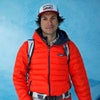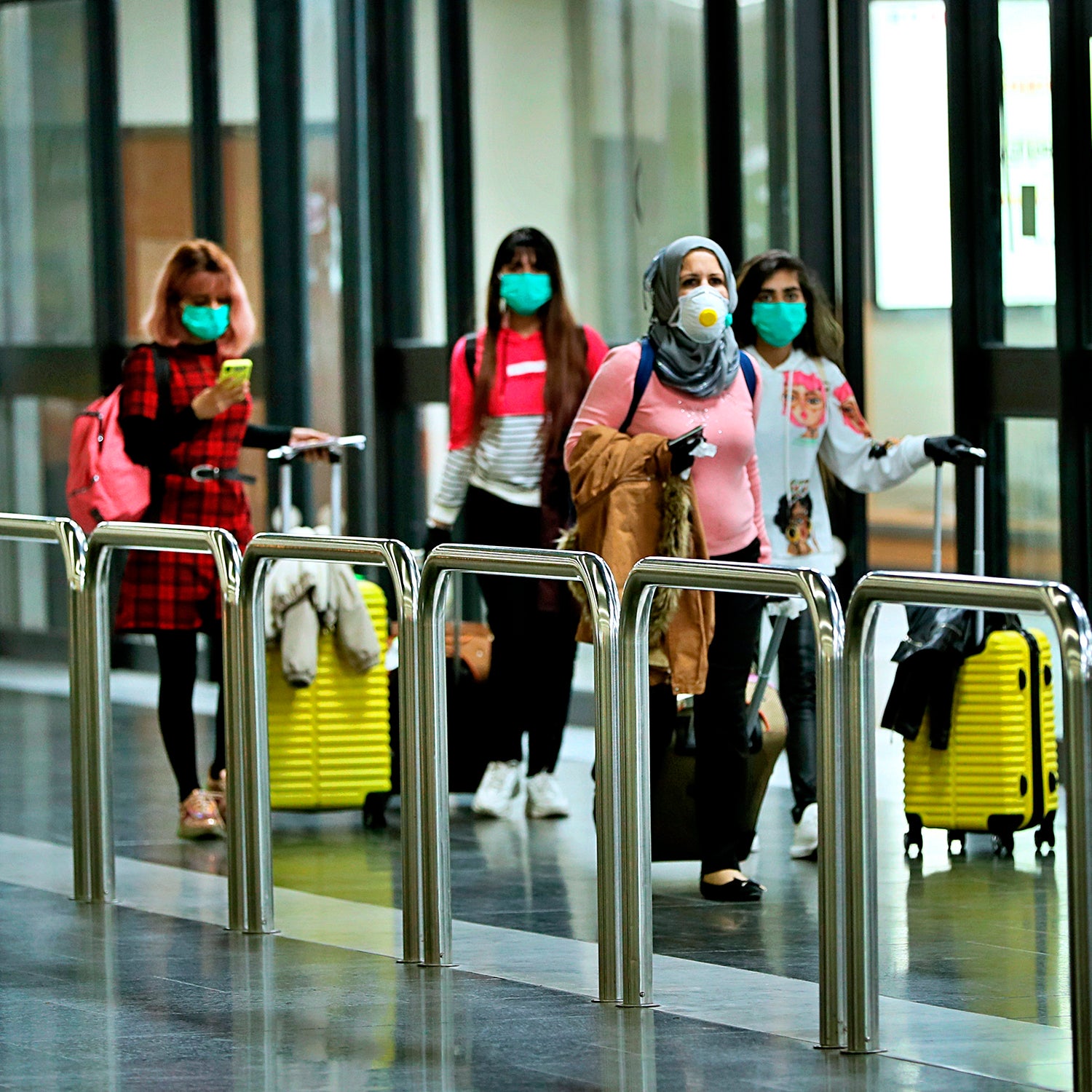The coronavirus disease—officially known as COVID-19—is hitting Europe and the Middle East and has made landfall in the U.S. with more than 100 cases. Like a lot of you, we’ve followed the outbreak with a mix of dread and fascination, and with frequent refreshes to the published by Johns Hopkins. The good news is that activities in the mountains—where people can remain at a safe distance from each other—will probably continue to be safe. But everything from yoga to the Olympics could get dicey.
Coronaviruses might live for up to nine days on countertops.
Nobody knows yet just how long the COVID-19 virus can remain viable on surfaces, but other coronaviruses—a category of virus that can cause illnesses ranging from common colds to deadly diseases like SARS and MERS—can stick around for . That means you’ll want to be careful about what you touch (looking at you, iPhone and airplane tray table). One of the most common forms of transmission is to get virus particles on your hands and then rub your eyes, mouth, or nose. Fortunately, SARS and MERS can both be (62 percent alcohol or more) or hydrogen peroxide, so possibly the new coronavirus can, too. In hospitals, technicians also use more powerful to disinfect sensitive areas, although it’s and best used by gloved professionals.��
The most effective protocol is to for 20 seconds or so. The foaming and rubbing action is important as it works viral particles out of the folds of your skin. Then apply an alcohol-based hand sanitizer. It takes alcohol 15 to 20 seconds to break down the lipid envelope that surrounds the virus proteins. Luckily, enveloped viruses are the easiest to destroy with alcohol. And while some have pointed out that ethanol may be more destructive to viruses than rubbing alcohol, it’s also more dehydrating to your skin, so use hand sanitizer.
It’s much deadlier than the flu and has the potential to kill millions of people.
Everyone from to the has made the point that the flu is currently a greater threat to public health than COVID-19. But the phrasing here is key. In a typical flu season, from the flu. And COVID-19 is just getting started; by the time of this article’s publication, it had already killed worldwide. But COVID-19 has the world on edge because of what it could do. Experts think it has the potential to infect an enormous percent of the global population—some say as many of —and cause enormous social and economic disruption.��
What makes COVID-19 so scary? Well, it’s highly transmissible: one infected person is likely to give the virus to . There are a few reasons for this. One, because COVID-19 is new, no one in the world has any immunity. Two, most—roughly —of the cases are mild or even asymptomatic, which means that those people with few symptoms can walk around infecting others rather than spending a couple of weeks laid up in bed. Three, the incubation period is relatively long: people can harbor the virus for two weeks or so before getting sick.��
So how deadly is it to individuals? “Globally, about 3.4 percent of reported COVID-19 cases have died,” said Tedros Adhanom Ghebreyesus, the World Health Organization’s director, . That’s still much higher than the flu (0.1 percent) but lower than .��
Lastly, and frighteningly, it appears that you can get reinfected. Unlike the flu, whose victims build up immunity to a specific strain after their illness, of people recovering from COVID-19 and then getting it again.
Fun things might be canceled.
For now, things like Mount Everest season, the Summer Olympics, and your favorite yoga class are still a go. But Olympic organizers are understandably worried. Dick Pound, a senior member of the International Olympic Committee last week that the IOC could afford to wait until May to make a decision about whether to move forward with the Games. The question they’re asking themselves: “Is this under sufficient control that we can be confident about going to Tokyo or not?” And if the virus is not under control, according to Pound, “you’re probably looking at a cancellation.”
Meanwhile, Everest expedition leader Adrian Ballinger, a fixture on the mountain for the past decade, tells us he’s altered his team’s plans to fly into Kathmandu and avoid major Chinese cities. The season kicks off around April 8, when groups begin flying into Nepal’s capital city. “Of course it’s still an unknown,” said Ballinger, “but the Chinese have hit all deadlines so far, and we have sent full payment for our permits.” Nepal has, to date, of coronavirus; however, if the disease were to spread there, it could quickly overwhelm the small nation’s health care resources.��
But when it comes to public crowds and normal human interaction, things may get sketchy when the disease starts to spread in the U.S. If the fallout in places like , Spain, and Austria are any indicator, professional sports events could be , large gatherings and festivals could be canceled, and .
Yes, you should stock up, but maybe not on what you’re thinking about.
In Hong Kong, coronavirus fears sparked a run on toilet paper, causing supermarket fights and even an . In all seriousness, experts say the are prudent amounts of any prescription medication you might need, as well as a small supply of dry goods like rice, beans, oats, and canned food that won’t go bad and that you’ll eat regardless. This is less about fears that supplies will run out and more about (or worse, if you yourself are sick).
Surgical masks probably don’t help.
While most of East Asia is outfitted in doctor’s masks these days, that’s more a than a medical necessity—mask-wearing “fosters a sense of a fate shared, mutual obligation, and civic duty,” anthropologist Christos Lynteris wrote recently . The World Health Organization says unless you’re a doctor—or you’re sick yourself. The best defense is washing your hands. If you do have to go into a high-risk situation (say, visiting a hospital during an outbreak), the mask to get is not the paper kind but an , which can filter out at least 95 percent of tiny particles. Even then you need to be sure the mask fits snugly against clean-shaven skin—sorry, —and that no air seeps in around the edges.
Get ready for “social distancing.”
Places from to to are already implementing what public health experts call “social distancing,” which basically means discouraging people from hanging out in groups. This can be anything from canceling school to forbidding social gatherings (the Chinese megacity of Guangzhou has ). Should coronavirus hit the U.S. hard, employers will likely call for work-from-home arrangements. But—fair warning—that means actually doing your job. Young bank trainees in Hong Kong were recently in the local press for getting caught hiking when they were supposed to be working from home.
You can spread the virus without showing symptoms.
This is part of what makes coronavirus so scary to infectious-disease experts. While SARS could only be transmitted via the obviously sick (i.e., those who were hacking and feverish), coronavirus carriers can fly under the radar with few or no symptoms. A 20-year-old woman from Wuhan but never had symptoms herself. And another woman infected a coworker at a meeting despite feeling nothing but a bit of fatigue. , people are the most contagious when they are the sickest. However, the agency reported that “some spread might be possible before people show symptoms.”
The difficulty of asymptomatic transmission means both that there are carriers out there spreading the virus around unknowingly and that people who get sick will have no idea where they contracted COVID-19. It’s a recipe for rapid transmission.
The worst part of the pandemic—if it becomes one—will probably occur November through next March.
Coronaviruses which is why flu season is in the winter. If the new coronavirus follows the patterns of past pandemics, it will spread during the spring in the Northern Hemisphere, die down over the summer, and then come roaring back as the weather cools in the fall. If the fatality rate is actually above 3 percent, the new coronavirus would , which followed a similar pattern. The pandemic actually emerged in late 1917 at a military hospital in France, spread through the winter and spring of 1918, but didn’t really take off until the virus mutated into a more virulent strain that emerged in August of that year and was far deadlier in its than in the first.
Some people are highly infectious “super-spreaders.”
A businessman attended a sales conference in Singapore, stopped off at a French ski resort to see some friends, then headed back to the UK. Little did he know he was spreading coronavirus the whole way. By the time he realized he was infected, he’d tagged 11 other Britons. Oh, and he still didn’t feel sick himself. No one is exactly sure , but it’s probably a , from the host’s immune system to their behavior (if they’re a hand washer) to where they happen to travel. Whatever it is, they’re dangerous. During the SARS epidemic in Singapore, just managed to be responsible for 144 out of 204 cases.
Don’t panic. It’s not time to go to your .
In fact, hoarding could make things even more dangerous. If masks and other protective gear are snapped up by the “,” there’ll be : medical professionals.



